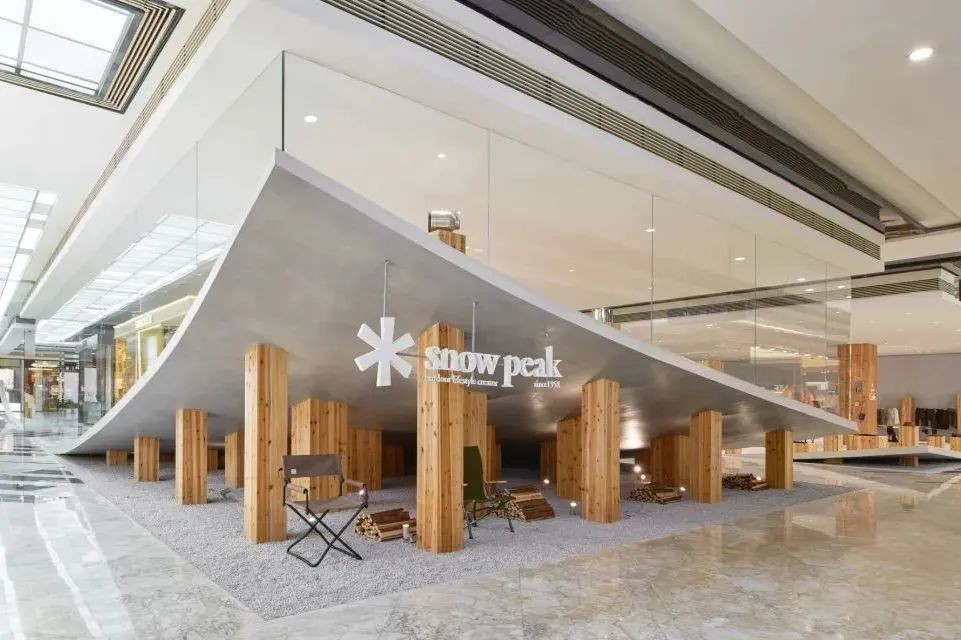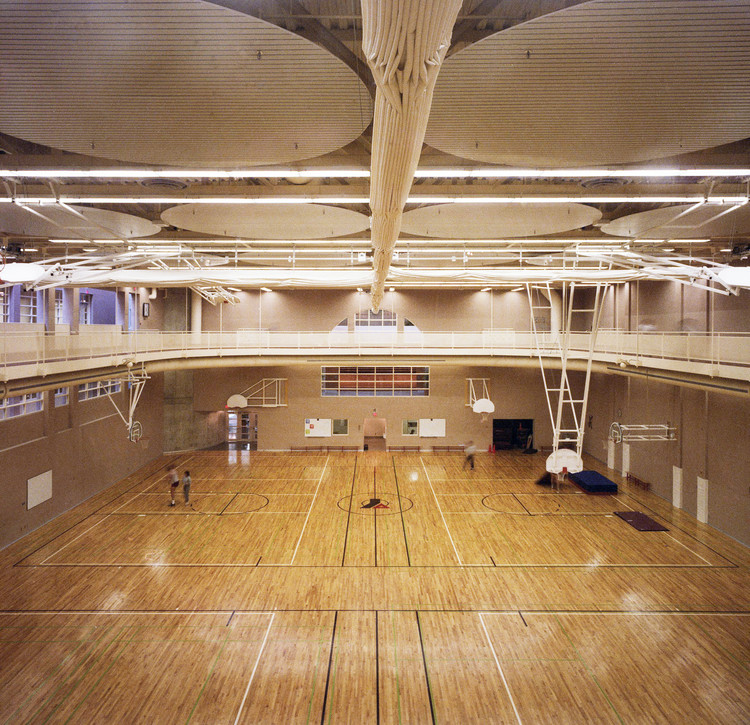Pinterest Headquarters All of the Above + First Office + Schwartz and Architecture
2013-12-16 01:00
© Naho Kubota
(Naho Kubota)


架构师提供的文本描述。当我们第一次见到Pinterest时,是为了讨论他们在Palo Alto的办公室。这个群体中有12人,但他们增长很快。埃文和本,Pinterest的创始人,要求我们设计一个能够反映他们非正统性格和成长的办公环境。我们的反应是通过不朽。与其为每一位新工程师买一张办公桌,我们还提出了一张能在很长一段时间内达到最大容量的大桌子。它测量了32英尺x32‘,可以很容易地容纳60人。当我们被邀请参加另一次会议时,这张桌子就投入生产了。
Text description provided by the architects. When we first met with Pinterest, it was to discuss their office in Palo Alto. There were 12 people in the group, but they were growing quickly. Evan and Ben, Pinterest’s founders, asked us to design an office environment that could reflect their unorthodox character and growth. Our response was through monumentality. Rather than buying a desk for every new engineer, we proposed one large table that would reach maximum capacity over a long period of time. It measured 32’ x 32’, and could easily fit sixty people. The table went into production, when we were called in for another meeting.
© Naho Kubota
(Naho Kubota)


公司爆炸了。Pinterest的规模增加了两倍,合伙人在旧金山发现了一座45,000平方英尺的仓库,可以很容易地容纳300人。他们想要一个永远处于创造状态的空间。无论公司规模有多大,设计师和工程师都会受到鼓励,贡献出他们最好的想法,填补空白,装饰,破坏,再展示一次。我们理解,就像网站本身一样,办公环境必须提供一个抽象的框架,在此框架内,协作、社会和情感关系可以开始形成和改变建筑空间。
The company had exploded. Pinterest had tripled in size and the partners found a 45,000 square foot warehouse in San Francisco that could easily fit 300 people. They wanted a space that would be in a perpetual state of creation. No matter how big the company got, designers and engineers would feel encouraged to contribute their best ideas, to fill in the blank, to decorate, destroy, and exhibit again. We understood, that like the website itself, the office environment would have to offer an abstract framework within which collaborative, social, and emotional relationships could begin to form and transform the architectural space.
© Naho Kubota
(Naho Kubota)


在下一次会议上,我们带来了一份计划、一份模型和一份报价-不是价格报价,我们确信他们会更喜欢-而是引用文学理论家维克托·什克洛夫斯基(Victor Shklovsky)1917年撰写的一篇简短的形式主义论文“艺术作为技巧”(Art as Technological)的话:
To our next meeting, we brought a plan, a model, and a quote—not a price quote, which we are sure they would have preferred—but a quote from the short formalist essay, “Art as Technique,” from 1917, by the literary theorist, Victor Shklovsky:
© Eddy Joaquim
c.Eddy Joaquim


“习惯会吞噬工作、衣服、家具、妻子和对战争的恐惧。“如果许多人的整个复杂生活都是无意识的,那么这种生活就像是他们从未经历过一样。”艺术的技巧是使物体‘不熟悉’,使形式变得困难,增加感知的难度和长度,因为感知的过程本身就是一个审美目的,必须延长。
"Habituation devours works, clothes, furniture, one’s wife, and the fear of war. ‘If the whole complex lives of many people go unconsciously, then such lives are as if they had never been.’ The technique of art is to make objects ‘unfamiliar,’ to make forms difficult, to increase the difficulty and length of perception because the process of perception is an aesthetic end in itself and must be prolonged."


我们认为,一个创造性的办公室不能单靠效率、连通性和生产力来运作。为了让每个人都能参与公司文化的创造,我们需要应对办公桌、会议室和角落办公室的习惯性环境。非习惯性办公空间的想法延续了Pinterest诞生的最初房子的某些特性。这里没有隔间或等级制度,只是一个家庭内部,由热爱科技的年轻人改造成一个工作场所。
We argued that a creative office cannot function on terms of efficiency, connectivity and productivity alone. For each person to take part in the creation of company culture, we would need to counter the habitual environment of the desk, the conference room, and the corner office. The idea of a non-habitual office space continued certain qualities of the initial house where Pinterest was born. There were no cubicles or hierarchies, just a domestic interior transformed by tech loving young people into a workplace.
© Naho Kubota
(Naho Kubota)


考虑到这些想法,我们设计了一个奇怪物体的目录。我们称之为“房屋”的大容量,会在开放的仓库里创造出口袋。不同的餐桌需要人们发明新的方法来组织一次会议,占据一个战争的房间,聚在一起吃一顿集体午餐,或者在酒吧里举办一个聚会。即使是最民主的圆桌,反过来,也会成为工程师们在最后期限内的封闭空间。在周围,白色和玻璃表面会变成白板、针板和涂鸦墙。家庭内部会随着社会交往而形成的物体、素描和观念变得更加浓密。
With these thoughts in mind, we designed a catalog of strange objects. Big volumes that we called ‘houses’ would create pockets within the open warehouse. Different monumental tables would require for people to invent new ways of organizing a meeting, occupying a war room, coming together for a collective lunch or throwing a party at the bar. Even the most democratic, circular table, in inverse, would become a lock-down room for engineers on a deadline. All around, white and glass surfaces would turn into white boards, pinboards, and graffiti walls. The domestic interior would grow thick with objects, sketches and ideas formed through social contact.
© Eddy Joaquim
c.Eddy Joaquim


我们在仓库里放了四间房子,在仓库的中心形成了一个巨大的聚集空间,在它的边缘形成了一条厚厚的基础设施走廊,其中的服务空间非常宽敞和压缩。我们希望人们能在这里看到与同事聊天的机会,深入工作,享受阳光或黑暗的房间,让血液涌向他们的头。
We placed four houses into the warehouse, forming at its center a big, gathering space and at its edges a thick infrastructural corridor with service spaces that are variously expansive and compressed. We hope people will see opportunity here to chat with their coworkers, go deep into their work, enjoy the heat of the sun or a darkened room, and let the blood rush to their heads.
























































Architects Schwartz and Architecture, All of the Above, First Office
Location San Francisco, CA, United States
Category Institutional Buildings
Project Designers All of the Above / First Office–Janette Kim, Anna Neimark and Andrew Atwood, with Charlie Able, Benjamin Farnsworth, Rachel Hillery, Mark Acciari, Austin Kaa, Steven Moody, Ewan Feng, Kate Hajash, Brian Lee, Darle Shinsato, Jane Zhu, Fiona Booth, Katie Okamoto, Margaret Zyro
Executive Architect Schwartz and Architecture–Neal Schwartz, Lourdes Garcia, Neil O’Shea, Wyatt Arnold, Erik Bloom, Joshua Yoches
Area 45000.0 ft2
Project Year 2013
Photographs Naho Kubota, Eddy Joaquim
























